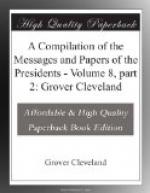the State’s quota of troops. Was called
to Albany in December for consultation concerning
the defenses of New York Harbor. Summoned a board
of engineers on December 24, of which he became a
member, and on January 18, 1862, submitted an elaborate
report on the condition of the national forts both
on the seacoast and on the inland border of the State.
Was appointed inspector-general February 10, 1862,
with the rank of brigadier-general, and in May inspected
the New York troops at Fredericksburg and on the Chickahominy.
In June, 1862, Governor Morgan ordered his return
from the Army of the Potomac, and he acted as secretary
of the meeting of the governors of the loyal States
which was held June 28 in New York City. At Governor
Morgan’s request, General Arthur resumed his
former work, resigned as inspector-general, and on
July 10 was appointed quartermaster-general. Retired
from the office December 31, 1862, when Horatio Seymour
succeeded Governor Morgan. Between 1862 and 1872
was engaged in continuous and active law practice—in
partnership with Henry G. Gardner from 1862 till 1867,
then for five years alone, and on January 1, 1872,
formed the firm of Arthur, Phelps & Knevals.
Was for a short time counsel for the department of
assessments and taxes, but resigned the place.
Continued during all this period to take an active
part in politics. Was chairman in 1868 of the
Central Grant Club of New York, and became chairman
of the executive committee of the Republican State
committee in 1879. Was appointed collector of
the port of New York by President Grant on November
20, 1871; was reappointed on December 17, 1875, and
confirmed by the Senate on the same day without reference
to a committee, a courtesy never before extended to
an appointee who had not been a Senator; retained the
office until July 11, 1878, when he was suspended by
President Hayes. On retiring from the office
of collector resumed the practice of law with the
firm of Arthur, Phelps, Knevals & Ransom. Advocated
in 1880 the nomination of General Grant to succeed
President Hayes. Was a delegate at large to the
Chicago convention, which met June 2, 1880. After
the nomination of General Garfield for the Presidency
a general desire arose in the convention to nominate
for Vice-President some advocate of General Grant
and a resident of New York State. The New York
delegation indicated their preference for General
Arthur, and he was nominated on the first ballot.
Was elected Vice-President November 2, 1880; took the
oath of office March 4, 1881, and presided over the
extraordinary session of the Senate that then began,
which was very exciting. That body being equally
divided, he was frequently called upon to exercise
the right of casting the controlling vote. President
Garfield was shot July 2, 1881, and died September
19. His Cabinet announced his death to the Vice-President,
then in New York, and at their suggestion he took
the oath as President on the 20th at his residence




